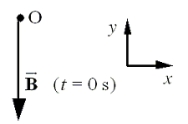The electromagnetic wave of the radiation field from a wire antenna travels toward the plane of your paper (which is in the -z direction) . At time t = 0 s, the wave strikes your paper at normal incidence. The magnetic field vector at point O in the figure points in the -y direction and has a magnitude of 4.0 × 10-8 T. The frequency of the wave is 1.0 × 1016 Hz. 
-What is the rms value of the magnetic field? Assume that the figure shows the peak value of  .
.
Definitions:
Lack of Evidence
A situation where there is insufficient proof or data to support a claim, hypothesis, or conclusion.
Sample Size
The number of observations or replicates to include in a statistical sample.
Data Collection
The systematic gathering of information from various sources for research, analysis, or making informed decisions.
Reliable Conclusions
Conclusions that are credible and trustworthy, typically derived from consistent, valid, and accurately interpreted data or reasoning.
Q17: Which one of the following quantities is
Q32: At what frequency do charges oscillate in
Q39: What is the direction of the electric
Q48: Four point charges, each of the same
Q49: What does one observe on the screen
Q50: Rocket A travels with speed 0.800c relative
Q54: Which one of the following graphs shows
Q55: A diffraction grating that has 4500 lines/cm
Q56: Light of wavelength 700.0 nm passes
Q83: The speed of light in material A